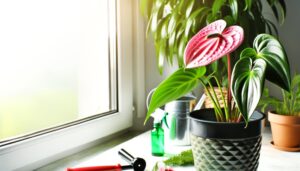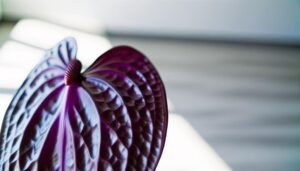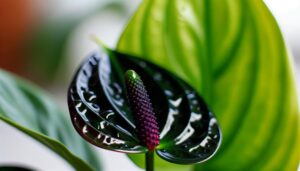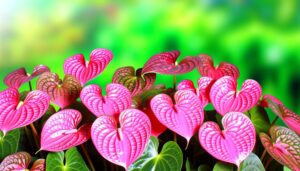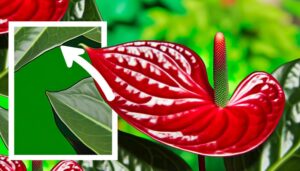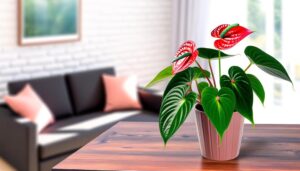What Is the Hawaiian Anthurium Society?
The Hawaiian Anthurium Society, founded in 1953, aims to advance anthurium cultivation with a specific focus on ideal horticultural practices. You'll learn about nutrient management, light exposure, and humidity control to achieve vibrant spathes and resilient foliage.
Embrace hybridization techniques to create diverse and disease-resistant varieties. Engage with integrated pest management strategies that minimize chemical use, and explore workshops that provide in-depth knowledge of propagation and substrate composition.
Membership offers access to advanced horticultural techniques, specialized guides, and personalized consultations. Discover how their detailed insights can elevate your anthurium growing practices.
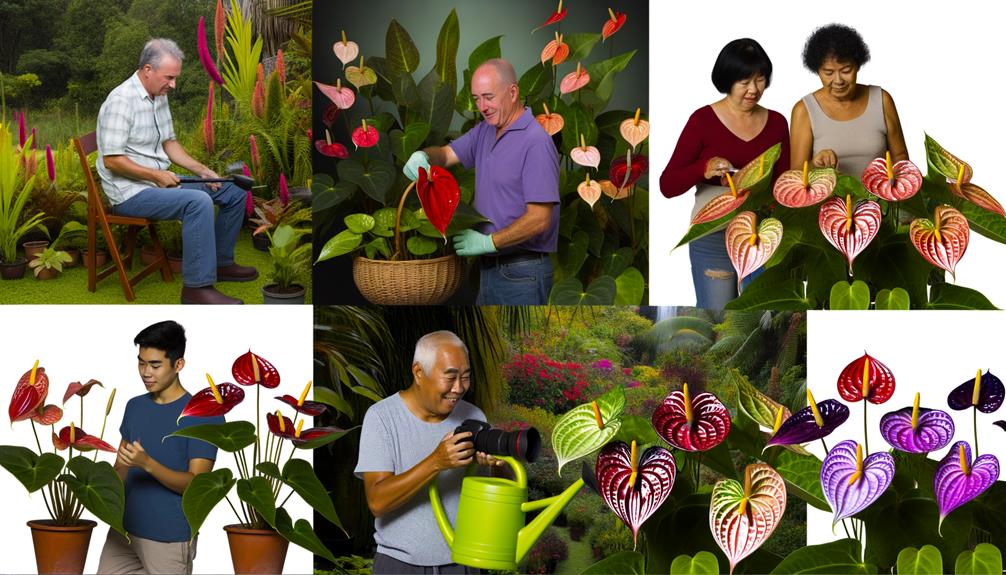
Key Takeaways
- Founded in 1953, the Hawaiian Anthurium Society promotes anthurium cultivation and hybridization.
- The Society offers workshops, seminars, and personalized consultations on advanced horticultural techniques.
- Membership provides access to a digital library, disease diagnostics, and specialized breeding programs.
- Focuses on sustainable practices, organic fertilization, and integrated pest management strategies.
- Engages the community through global partnerships, collaborative research, and plant swaps.
History and Founding
The Hawaiian Anthurium Society was founded in 1953 to promote the cultivation and appreciation of anthuriums, focusing on their unique horticultural requirements and the enhancement of their vibrant spathes and foliage.
You'll find that the society's roots are deeply intertwined with the rich volcanic soils of Hawaii, which provide the perfect medium for these tropical beauties.
Early members meticulously studied nutrient management, light exposure, and humidity control, setting high standards for anthurium care. They perfected propagation techniques, including tissue culture and cuttings, ensuring robust root systems and disease resistance.
The society also emphasized the importance of hybridization to produce anthuriums with striking color variations and resilient foliage, making them a staple in both home gardens and commercial landscapes.
Mission and Vision
Committed to advancing anthurium cultivation, the Hawaiian Anthurium Society's mission focuses on research-driven horticultural practices and fostering a global appreciation for these stunning tropical plants. You'll find that our vision encompasses the enhancement of anthurium genetic diversity, sustainable growing techniques, and educational outreach to both novice and expert growers. We're dedicated to promoting best practices in pest management, soil health, and hybridization.
| Objective | Initiative | Outcome |
|---|---|---|
| Genetic Diversity | Breeding Programs | New Varieties |
| Sustainable Techniques | Organic Fertilization | Healthier Plants |
| Education | Workshops & Seminars | Knowledge Sharing |
| Pest Management | Integrated Pest Control | Reduced Chemical Use |
| Community Engagement | Global Partnerships | Collaborative Research and Events |
Membership Benefits
Joining the Hawaiian Anthurium Society provides access to exclusive resources such as advanced horticultural techniques, plant disease diagnostics, and specialized breeding program insights.
You'll explore sophisticated propagation methods, including tissue culture and controlled pollination, ensuring robust plant health and genetic diversity. Our detailed guides on identifying and combating pathogens like Xanthomonas axonopodis will equip you with the know-how to protect your prized Anthuriums.
Membership also grants you access to an extensive digital library filled with scholarly articles on Anthurium care, nutrient management, and hybridization strategies.
Personalized consultations with experienced horticulturists will help you troubleshoot issues and refine your cultivation practices. By joining, you're not just growing plants; you're expanding your expertise and passion for Anthuriums.
Events and Workshops
How can you deepen your knowledge and hands-on skills with Anthuriums? Attend the Hawaiian Anthurium Society's events and workshops.
You'll explore propagation techniques, pest management, and ideal growing conditions. Expert-led sessions cover intricate details like substrate composition, humidity control, and light requirements for various Anthurium species.
Workshops often include guided tours of specialized nurseries, allowing you to observe advanced cultivation practices in real-time. Interactive demonstrations offer a tactile experience with root pruning, leaf cleaning, and bloom preservation techniques.
Networking opportunities abound, connecting you with fellow enthusiasts and seasoned growers.
Cultivation Techniques
To cultivate thriving anthuriums, you'll need to focus on well-draining, organic-rich soil and balanced nutrient applications.
Guarantee consistent watering practices, avoiding both waterlogging and drought stress.
Stay vigilant for common pests like aphids and mealybugs, and implement integrated disease management strategies to maintain plant health.
Soil and Nutrient Needs
Anthuriums thrive in well-draining, organic-rich ground that's slightly acidic. They typically achieve best growth in a combination of peat moss, pine bark, and perlite. This mix guarantees ideal aeration and moisture retention, mimicking their natural epiphytic habitat.
You'll want to maintain the soil pH between 5.5 and 6.5 for nutrient absorption. Integrate slow-release, balanced fertilizers rich in nitrogen, phosphorus, and potassium to support leaf and blossom development. Micronutrients like magnesium and calcium are crucial for vivid blooms and sturdy growth.
Avoid dense, clay-based soils that retain water, as anthuriums are vulnerable to root decay. Regularly renew the soil mix to prevent compression and sustain nutrient availability, ensuring your anthuriums thrive with minimal strain.
Ideal Watering Practices
Ensuring perfect hydration, you'll need to water anthuriums thoroughly but infrequently, allowing the top inch of soil to dry out between waterings to prevent root rot. Anthuriums thrive in well-draining, aerated substrates. Overwatering can suffocate roots, leading to chlorosis or wilting. Utilize tepid, dechlorinated water to mimic their natural tropical environment.
Pay attention to leaf curling or browning edges—signs of either drought stress or overwatering. During active growth phases, maintain consistent moisture levels without waterlogging. In dormancy, reduce watering frequency. Invest in a moisture meter for precise monitoring.
Settle your anthurium in a humidity-rich location, ideally between 60-80%, to support optimal hydration. By mastering these watering nuances, you'll sustain vibrant, flourishing anthuriums.
Pest and Disease Control
In the field of anthurium cultivation, vigilant pest and disease control is crucial to maintaining plant health and vigor. You'll encounter common pests like aphids, thrips, and mealybugs. To combat these, apply insecticidal soap or neem oil, making sure of thorough leaf coverage.
Root rot, often caused by Phytophthora, demands precise watering and well-draining soil. Inspect roots regularly for mushiness or discoloration. Bacterial blight, identified by water-soaked lesions on leaves, necessitates immediate removal of infected foliage and application of copper-based fungicides. Regularly sanitize tools to prevent pathogen spread.
Monitor your plants closely, as early detection is key. By maintaining a proactive approach, you'll secure your anthuriums flourish with minimal pest and disease interference.
Pest Management
When managing anthurium pests, you'll often encounter common culprits like aphids, mealybugs, and thrips. Identifying these pests early is essential; look for signs such as distorted leaves, sticky residue, or black sooty mold.
Implement effective control strategies, including neem oil applications and introducing beneficial insects like ladybugs and lacewings.
Common Pests Identification
Identifying common pests like aphids, mealybugs, and spider mites is essential for effective pest management in anthuriums. Aphids often cluster on new growth, sucking sap and excreting honeydew, which can lead to sooty mold.
Mealybugs, with their white, cotton-like appearance, hide in leaf axils and under leaves, weakening plants by feeding on their juices.
Spider mites, almost microscopic, create fine webbing on the undersides of leaves and puncture plant cells, causing stippling and discoloration. Recognizing these pests early is key. You'll notice distorted leaves, sticky residue, and webbing.
Inspect your anthuriums regularly, focusing on new growth and the undersides of leaves. Early detection allows you to address infestations promptly, keeping your plants healthy and vibrant.
Effective Control Strategies
Effective pest management for anthuriums involves a combination of cultural practices, biological controls, and, when needed, chemical treatments to guarantee the health and vibrancy of your plants. Start by ensuring ideal growing conditions: maintain proper humidity levels and adequate air circulation to prevent infestations.
Utilize natural predators like ladybugs and predatory mites to control aphids and spider mites. Neem oil and insecticidal soaps can be effective for minor outbreaks without harming your anthuriums. For severe cases, you might need systemic insecticides; however, always follow the label instructions meticulously.
Regularly inspect your plants for early signs of pests and act promptly. By integrating these strategies, you'll foster a robust environment that supports your anthuriums' lush growth and striking blooms.
Hybridization Insights
Explore the complexities of hybridization to grasp how cross-pollination techniques can create anthuriums with enhanced color vibrancy and disease resistance. By selecting parent plants exhibiting desirable traits, you can manipulate genetic diversity. Utilize controlled environments to optimize fertilization success.
Techniques like emasculation and bagging guarantee purity of pollen transfer between chosen specimens. Observe the resultant hybrids for phenotypic improvements—intensified hues, enhanced foliar patterns, and heightened resilience to pathogens. Documenting these traits meticulously aids in understanding heritability patterns.
Engage in tissue culture propagation to multiply successful hybrids efficiently. Your hands-on experience and detailed records will contribute significantly to the evolving landscape of anthurium cultivation, pushing the boundaries of what these exotic plants can achieve.
Community Engagement
Engaging with the local horticultural community through workshops and plant swaps can greatly enhance your understanding and cultivation of anthuriums. You'll exchange detailed insights about ideal growing conditions, like specific humidity levels and the best soil mix for root aeration.
During workshops, experts might demonstrate advanced propagation techniques, such as tissue culture or controlled pollination. Plant swaps offer you a chance to acquire rare anthurium hybrids and discuss pest management strategies. You'll also benefit from firsthand advice on nutrient regimens tailored for anthuriums' unique requirements.
Active participation in these events fosters a deep sense of camaraderie and shared purpose, enriching your horticultural journey and enabling you to cultivate healthier, more vibrant anthuriums.
Conclusion
In joining the Hawaiian Anthurium Society, you'll gain unparalleled access to expert advice on anthurium cultivation techniques, pest management, and hybridization insights.
With a community that values knowledge-sharing, you'll find that 'many hands make light work.'
Attend events and workshops to deepen your understanding and connect with fellow enthusiasts.
Membership offers a blend of scientific expertise and hands-on practice, ensuring your anthuriums thrive.
Don't miss out on this vibrant, supportive community dedicated to these stunning tropical plants.

